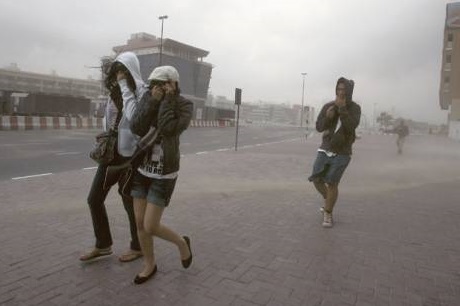Residents prone to allergies advised to stay indoors
A major sandstorm is expected to hit the UAE this weekend. The National Centre of Meteorology and Seismology (NCMS) has forecast a sandstorm to come to the UAE on Friday.
The storm is expected to create a visibility of less than 500 meters.
The sandstorm will erupt in Iraq and travel through Kuwait to hit the UAE on Friday, gripping the country for two days.
Wind speeds of 25-35 knots are expected.
Meanwhile, experts at a seminar on Wednesday spoke about the nature and possible consequences of a sandstorm.
Mazen Altaruti, Managing Director, MSD Gulf, which held the seminar, said: “On an average, the UAE faces between 8 and 10 severe sandstorms each year. In many cases these sandstorms can last for several hours or sometimes even the whole day, bring traffic to a standstill, forcing places of work and school to close and significantly increasing the number of hospitalizations.”
With the vast desert surrounding most areas in the UAE, the country is prone to experience sandstorms. “When the visibility reaches below 1 kph, we can speak of a sandstorm,” said Sufian Farah, Weather Forecasting Specialist from the National Centre of Meteorology and Seismology (NCMS).
With wind speeds of 35-50 knots, dust particles are carried in the air from desert areas, and travel overland until the wind speed decreases. In the UAE, sandstorms mostly come from the south of Iraq, traveling via Kuwait into the UAE.
Officials have suggested that hospital admissions due to respiratory diseases such as asthma have increased by as much as 25 per cent over the last few years, as a result of severe weather; particularly sandstorms.
Hussain Abdel Rahman, Director of Medical Affairs and Head of the ENT Department at Dubai Hospital said: “Sandstorms are a major cause of bacterial and viral infection particular amongst those with weaker immune systems such as the elderly and pediatrics, in addition to those with compromised immune systems.
“Additionally, because of the large amount of pollen these storms carry, allergies commonly known as allergic rhinitis, are also a problem. In severe cases and when left untreated, allergic rhinitis can lead to asthma, even in patients with no previous history of this illness.”
According to Hussain unawareness is a major concern, as people might not be aware of the effects a sandstorm can have on their health. “When experiencing difficulty in breathing, or hearing a soundwhen breathing, it is advisory to consult a doctor.”
People aware of having allergic rhinitis, should stay inside as much as possible during a sandstorm, closing doors and windows. When one must go outside, nose and mouth should be covered.
Although it is difficult to say how often a sand storm may erupt in a year, Sufian said that in transition time between seasons, sandstorms are most common.
Western areas are most likely to be affected, although Abu Dhabi saw one of the highest sandstorm rates in 2008 – 128 events of sandstorms.

